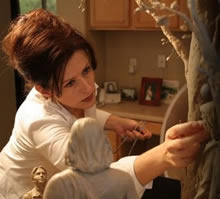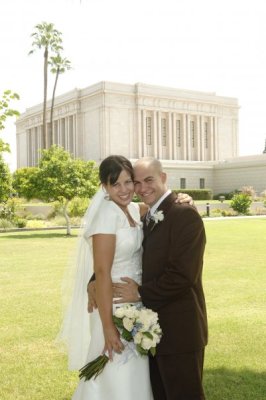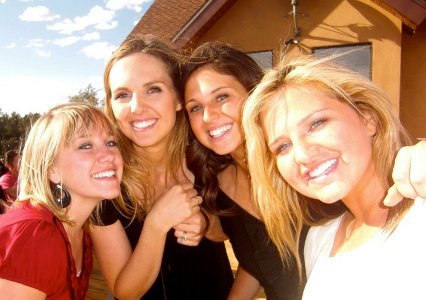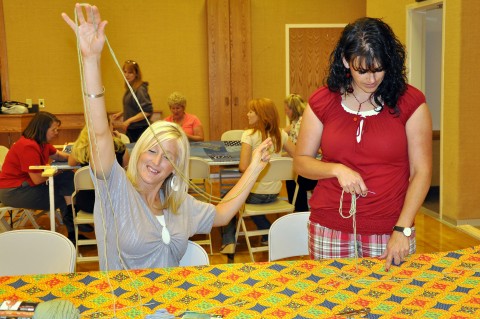Difference between revisions of "Mormon Women"
Elya Ghent (talk | contribs) |
m |
||
| Line 31: | Line 31: | ||
The women in the LDS Church are wives, daughters, sisters, aunts, and friends of faith and virtue. They, alongside the men of the Church, carry forward the Gospel and lead through divine inspiration. They provide comfort and support to their husbands and nurture their families in love and faith. Although for Mormon women home and family are the top priority, most pursue higher education and work outside the home when it is necessary, or before and after childrearing. Some work part-time, while many are professionals. Mormon women are found in science, academe, the arts, education, medicine, and indeed, all vocations. | The women in the LDS Church are wives, daughters, sisters, aunts, and friends of faith and virtue. They, alongside the men of the Church, carry forward the Gospel and lead through divine inspiration. They provide comfort and support to their husbands and nurture their families in love and faith. Although for Mormon women home and family are the top priority, most pursue higher education and work outside the home when it is necessary, or before and after childrearing. Some work part-time, while many are professionals. Mormon women are found in science, academe, the arts, education, medicine, and indeed, all vocations. | ||
| − | Spiritual connectedness to the Lord through the constant companionship of the [[Holy Ghost]] is at the center of discipleship for Mormon women. Mormon women are encouraged to counsel with the Lord in all of their decisions. Said Barbara Smith, former Relief Society General President, | + | Spiritual connectedness to the Lord through the constant companionship of the [[Holy Ghost]] is at the center of [[discipleship]] for Mormon women. Mormon women are encouraged to counsel with the Lord in all of their decisions. Said Barbara Smith, former Relief Society General President, |
:"Women who are bored, frustrated, lonely, and unhappy are terribly handicapped in also trying to be righteous. For some, the answer is changing their circumstances. For others, the answer is changing their character to meet those circumstances. I have faith that our Heavenly Father, desiring our happiness more truly than we can know this side of the veil, will help each woman find what she should do if she’ll pay the price to know." | :"Women who are bored, frustrated, lonely, and unhappy are terribly handicapped in also trying to be righteous. For some, the answer is changing their circumstances. For others, the answer is changing their character to meet those circumstances. I have faith that our Heavenly Father, desiring our happiness more truly than we can know this side of the veil, will help each woman find what she should do if she’ll pay the price to know." | ||
Revision as of 23:33, 25 October 2012
Contents
Do Mormons believe in equality of the sexes?
Mormons believe in full equality between men and women, but they also believe that men and women have different roles because of gender.
Latter-day Saint women celebrate their differences from men, believing that the union of a man and woman is divinely appointed. Sheri L. Dew, a member and former leader of the Relief Society (the 6 million strong Church organization for women) stated, "He made us enough alike to love each other, but enough different that we would need to unite our strengths and stewardships to create a whole. Neither man nor woman is perfect or complete without the other" ("It Is Not Good for Man or Woman to Be Alone," Ensign, Nov. 2001, 12).
Elder Neal A Maxwell, a prominent Church leader from 1974 up to his death in 2004, added this view concerning husbands and wives:
- "When we kneel to pray, we kneel together. When we kneel at the altar of the holy temple [to be married], we kneel together. When we approach the final gate where Jesus Himself is the gatekeeper, we will, if faithful, pass through that gate together" ("The Women of God," Ensign, May 1978, 10).
While men and women are equal partners in marriage, the Mormon church recognizes that men and women are different, too:
- "We cannot eliminate, through any pattern of legislation or regulation, the differences between men and women. There are basic things that a man needs that a woman does not need. There are things that a man feels that a woman never does feel. There are basic things that a woman needs that a man never needs, and there are things that a woman feels that a man never feels nor should he." (Boyd K. Packer, "The Equal Rights Amendment", Ensign, March 1977, page 6)
Mormon women are not subservient to Mormon men:
- “The place of woman in the Church is to walk beside the man, not in front of him nor behind him. In the Church there is full equality between man and woman. The gospel … was devised by the Lord for men and women alike. Every person on earth, man or woman, earned the right in the pre-existent life to come here; and must earn the right, by righteous actions, to live hereafter where ‘God and Christ dwell.’ ... The privileges and requirements of the gospel are fundamentally alike for men and women. The Lord loves His daughters as well as He loves His sons. ... This makes individuals of man and woman—individuals with the right of free agency, with the power of individual decision, with individual opportunity for everlasting joy, whose own actions throughout the eternities, with the loving aid of the Father, will determine individual achievement. There can be no question in the Church of man’s rights versus woman’s rights” (Improvement Era, Mar. 1942, p. 161).
Mormon women are expected to exercise their divine right to achieve the highest temple ordinances:
- “Never in history have women enjoyed the freedom of thought and action accorded the women of this Church. From the day of its restoration women have been accorded their full religious franchise, and in the temples of the restored Gospel a man may not partake of the highest ordinances without his wife by his side. In all life pursuits she is given her entire independence. This gives to woman a mighty responsibility which, if she honors and uses, will be increased in power upon her; but if she ignores it or treats it lightly or fails to magnify it, she may lose that which she now possesses and thereby forfeit her birthright. For this great privilege women of this Church should be eternally grateful and willing to use and cherish this precious and priceless relationship. Where much is given, much is expected” (Leah D. Widtsoe, Priesthood and Womanhood, as quoted in Priesthood and Church Government, comp. John A. Widtsoe, pp. 90–91).
The Divine Role of Women
Elder Maxwell continues explaining women's roles in the Church and in the eyes of God by citing some of the notable women of the Bible: "When we would measure loving loyalty in a human relationship, do we not speak of Ruth and Naomi even more than David and Jonathan? . . . A widow with her mite taught us how to tithe. An impoverished and starving widow with her hungry son taught us how to share, as she gave her meal and oil to Elijah. The divine maternal instincts of an Egyptian woman retrieved Moses from the bullrushes, thereby shaping history and demonstrating how a baby is a blessing—not a burden. . . . Does it not tell us much about the intrinsic intelligence of women to read of the crucifixion scene at Calvary, "And many women were there beholding afar off" (Matthew 27:55). Their presence was a prayer; their lingering was like a litany. And who came first to the empty tomb of the risen Christ? Two women. Who was the first mortal to see the resurrected Savior? Mary of Magdala. Special spiritual sensitivity keeps the women of God hoping long after many others have ceased" ("The Women of God," Ensign, May 1978, 10).
Mormon women are encouraged to develop their femininity, though they define the word differently than the world does. James E. Faust, a counselor in the First Presidency, the leading council of the Church, in speaking to the women of the Church defined femininity as follows: "Femininity is not just lipstick, stylish hairdos, and trendy clothes. It is the divine adornment of humanity. It finds expression in your qualities of your capacity to love, your spirituality, delicacy, radiance, sensitivity, creativity, charm, graciousness, gentleness, dignity, and quiet strength. It is manifest differently in each girl or woman , but each of [them] possesses it. Femininity is part of your inner beauty" ("Womanhood: The Highest Place of Honor," Ensign, May 2000, 95).
The women in the LDS Church are wives, daughters, sisters, aunts, and friends of faith and virtue. They, alongside the men of the Church, carry forward the Gospel and lead through divine inspiration. They provide comfort and support to their husbands and nurture their families in love and faith. Although for Mormon women home and family are the top priority, most pursue higher education and work outside the home when it is necessary, or before and after childrearing. Some work part-time, while many are professionals. Mormon women are found in science, academe, the arts, education, medicine, and indeed, all vocations.
Spiritual connectedness to the Lord through the constant companionship of the Holy Ghost is at the center of discipleship for Mormon women. Mormon women are encouraged to counsel with the Lord in all of their decisions. Said Barbara Smith, former Relief Society General President,
- "Women who are bored, frustrated, lonely, and unhappy are terribly handicapped in also trying to be righteous. For some, the answer is changing their circumstances. For others, the answer is changing their character to meet those circumstances. I have faith that our Heavenly Father, desiring our happiness more truly than we can know this side of the veil, will help each woman find what she should do if she’ll pay the price to know."
Mormon Women and Education
As beings with divine destiny, the Mormon church strongly encourages its women to educate themselves. Mormon women have been encouraged to improve themselves through education since the 1800s. Speaking in 1893 to the Women’s Auxiliary of the Parliament of Religions in Chicago, Emily S. Richards said of Mormon women: “The whole world of science, religion, philosophy, politics, history, art, and literature is open to [Mormon] women, and they may wander in these limitless fields of knowledge when and how and to what extent they choose.”
Brigham Young said about educating women: "I would not have them neglect to learn music and would encourage them to read history and the Scriptures, to take up a newspaper, geography, and other publications, and make themselves acquainted with the manners and customs of distant kingdoms and nations, with their laws, religion, geographical location on the face of the world, their climate, national productions, the extent of their commerce, and the nature of their political organization; in fine, let our boys and girls be thoroughly instructed in every useful branch of physical and mental education" (Journal of Discourses, 9:189).
Encouragement for Mormon women to educate themselves continues today: "Every young woman ought to be encouraged to refine her skills and increase her abilities, to broaden her knowledge and strengthen her capacity" (Gordon B. Hinckley).
“Some are inclined toward formal university training, and some are inclined more toward the practical vocational training. We feel that our people should receive that kind of training which is most consistent with their interests and talents. Whether it be in the professions, the arts, or the vocations; whether it be university or vocational training, we applaud and encourage it” (Spencer W. Kimball "Foundations of Righteousness", Ensign, November 1977, page 4).
“There are impelling reasons for our sisters to plan toward employment. ... We want them to obtain all the education and vocational training possible before marriage. If they become widowed or divorced and need to work, we want them to have dignified and rewarding employment. If a sister does not marry, she has every right to engage in a profession that allows her to magnify her talents and gifts” (Howard W. Hunter, "Prepare for Honorable Employment",Ensign, November 1975, page 124).
“Too great care cannot be taken in educating our young ladies. Great responsibilities will devolve upon them. To their hands will be mainly committed the formation of the moral and intellectual character of the young. Let the women of our country be made intelligent, and their children will certainly be the same. The proper education of a man decides his welfare; but the interests of a whole family are secured by the correct education of a woman” (George Q. Cannon, Gospel Truth, sel. Jerreld L. Newquist [Salt Lake City: Deseret Book Co., 1974], 2:138).
Mormon Women and the Priesthood
Women play an integral role in the work of The Church of Jesus Christ of Latter-day Saints. While women are not ordained to the priesthood in the Church and do not therefore officiate in rites such as blessing the sacramental emblems or baptizing, they serve in senior leadership positions and as missionaries and teachers, and they routinely preach from the pulpit and lead congregational prayers in worship services.
Mormons believe the priesthood provides men divine assistance that can help them perform their God-given duties as fathers and leaders in the Church. Women's God-given family responsibilities are equally as essential as male roles, but do not require priesthood authority to perform. Both men and women will someday be held accountable for their family obligations and stewardships.
Mormon Apostle Dallin H. Oaks said this about the matter:
- President [Joseph Fielding] Smith explained: "While the sisters have not been given the Priesthood, … that does not mean that the Lord has not given unto them authority. Authority and Priesthood are two different things. A person may have authority given to him, or a sister to her, to do certain things in the Church that are binding and absolutely necessary for our salvation, such as the work that our sisters do in the House of the Lord" (Relief Society Magazine, Jan. 1959, p. 4).
- President Smith's teaching on authority explains what the Prophet Joseph Smith meant when he said that he organized the Relief Society "under the priesthood after the pattern of the priesthood." The authority to be exercised by the officers and teachers of the Relief Society, as with the other auxiliary organizations, was the authority that would flow to them through their organizational connection with The Church of Jesus Christ of Latter-day Saints and through their individual setting apart under the hands of the priesthood leaders by whom they were called ("The Relief Society and the Church," Ensign, May 1992, 34).
Modern Prophets Speak About Women
"Woman is God's supreme creation. Only after the earth had been formed, after the day had been separated from the night, after the waters had been divided from the land, after vegetation and animal life had been created, and after man had been placed on the earth, was woman created; and only then was the work pronounced complete and good" ("Our Responsibility to Our Young Women," Ensign, Sept. 1988, 8). This is how Gordon B. Hinckley, former President of the LDS or Mormon Church, describes the Church's view of women and their divine role.
Said Heber J. Grant, a former President of the Mormon Church from 1918-1945, "The true spirit of the Church of Jesus Christ of Latter-day Saints gives to woman the highest place of honor in human life. To maintain and to merit this high dignity she must possess those virtues which have always, and which will ever, demand the respect and love of mankind … [because] ‘a beautiful and chaste woman is the perfect workmanship of God" (Improvement Era, May 1935, 276).
Mormons believe that "all human beings—male and female—are created in the image of God. Each is a beloved spirit son or daughter of heavenly parents, and, as such, each has a divine nature and destiny. Gender is an essential characteristic of individual pre-mortal, mortal, and eternal identity and purpose" ("The Family: A Proclamation to the World," Ensign, Nov. 1995, 102).
"Of all the creations of the Almighty, there is none more beautiful, none more inspiring than a lovely daughter of God who walks in virtue with an understanding of why she should do so, who honors and respects her body as a thing sacred and divine, who cultivates her mind and constantly enlarges the horizon of her understanding, who nurtures her spirit with everlasting truth" (Gordon B. Hinckley, "Our Responsibility to Our Young Women," Ensign, Sept. 1988, 8).
President Gordon B. Hinckley led the men of the Church by his example of treatment toward women. His beloved wife of 67 years, Marjorie Paye Hinckley, said to him: “You have always given me wings to fly, and I have loved you for it” (“The Women in Our Lives,” Ensign, Nov. 2004, 82).
Prophet Gordon B. Hinckley states, "In this Church the man neither walks ahead of his wife nor behind his wife but at her side. They are co-equals in this life in a great enterprise." (Mormons.org Why don't Mormon women hold the priesthood?)
Quotes from Mormon Women
- I recently heard a woman of another faith say she didn’t think much of Mormons because she believed an LDS friend of hers wasn’t allowed to participate at Church. What a tragic misperception! From the time we can string three words together, we’re serving. There is no group of women anywhere who teach more, lead more, or speak more—or are better at it. Right now, hundreds of thousands of us are teaching children, youth, and adults. Hundreds of thousands more are serving in presidencies. I’ve looked, and I can’t find any religion, government, or business where so many women have as much influence as in The Church of Jesus Christ of Latter-day Saints. But we are the only ones who can send that message. We are the ones who need to define Latter-day Saint womanhood, not anyone else. This means speaking up and reaching out (Sheri Dew, BYU Women's Conference, 2008).
- There is evidence all around us that the world desperately needs women who stand for something good and noble and righteous-even if that stand may not be popular. The world needs women who in their daily acts and deeds exemplify a higher standard. Women may not be the soldiers who lead our country into battle against evil forces, but every day they are at the front of the battle that Satan wages for souls. The example of a righteous woman-a woman who has made covenants with God and keeps them-is of paramount importance. In all our roles in the family, in professions and the community, in our neighborhoods and in our Church callings, our actions resonate as loudly as a calling voice booms through a narrow canyon (Virginia U. Jensen, BYU Women's Conference, 2000).
- As we come to better understand and appreciate Christ's enabling yoke, we begin to love the cost as well as the promise. Christ has designed a kindly yoke for each us, made to fit our individual abilities and circumstances. It does not chafe and gouge but fortifies and protects. When we cheerfully receive his yoke as a gift and submit to the balanced load he commissions us individually to carry, there comes into our lives a renewed reverence and awe for our Redeemer and Deliverer. In a most powerful manner, we learn that he indeed loves us and is teaching us in every possible manner to become like him (Camille Fronk, BYU Women's Conference, 1999).
The Influence of Mormon Women
Through the Relief Society, or women's auxiliary of the Church, a huge amount of humanitarian aid is performed on a consistent basis. Said Relief Society General President Julie B. Beck, “We have covenanted to follow the pattern of service defined by Jesus Christ. We try to do what He would do.” Within the wards and stakes of the Church, humanitarian aid projects are ongoing, but Mormon women also participate in projects outside those organized by the Church. Some have been spontaneously begun by individual women and grown in scope over the years. Thousands reach beyond the boundaries of their own homes, even their own communities, to provide relief to people in need.
Mormon women refine and develop their talents. The producers of the opening and closing ceremonies of the 2002 Winter Olympics in Salt Lake City were astonished by the abundance of local talent. They had expected to import outside performers, but relied mostly on the polished performers available from families in Utah. Both American Idol and So You Think You Can Dance reality TV talent shows have established auditions in Salt Lake City, because of the native talent. Famous LDS performers include Marie Osmond, Gladys Knight, Brooke White and Carmen Rasmussen of American Idol, Chelsie Hightower and Julianne Hough of Dancing with the Stars, and SHeDAISY.
In the news lately is Stephenie Meyer whose Twilight series has impressed young adults (and their parents) everywhere. Artists such as the late Minerva Teichert and prolific Liz Lemon Swindle dazzle with their inspired creations. Mormon women are found in every walk of life, but also perform constant acts of charity in their own families and neighborhoods, school PTAs, and community organizations.
See Also
External Links
- Mormon Women: A Convert's Perspective by Carolyn J. Rasmus
- What does "help-meet" really mean?
- The Lord as a Role Model for Men and Women by Ida Smith
- A Woman's Perspective on the Priesthood by Patricia T. Holland
- Mormon Women's Conference transcripts
- Mormon Women Reach Out to Serve in their Communities and Around the World
- Mormon Women Work to Save Premature Babies
- Mormon Women Sew Clothes for Children in Malawi
- Cultural challenges of LDS women around the world
- Mormon women receive mother-of-the-year awards
- President Monson cautions husbands





